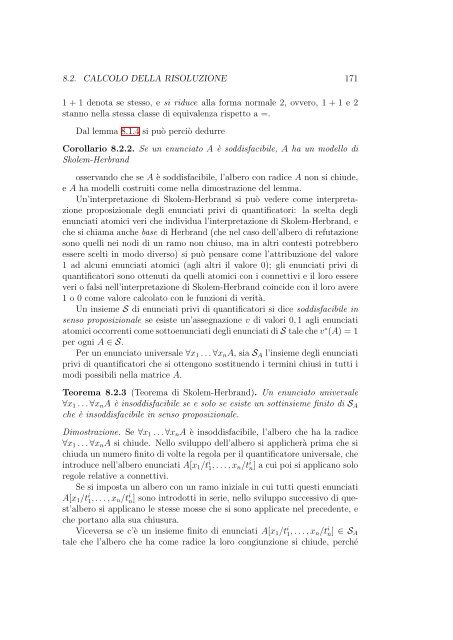Logica Matematica Corso di Laurea in Informatica ... - Mbox.dmi.unict.it
Logica Matematica Corso di Laurea in Informatica ... - Mbox.dmi.unict.it
Logica Matematica Corso di Laurea in Informatica ... - Mbox.dmi.unict.it
You also want an ePaper? Increase the reach of your titles
YUMPU automatically turns print PDFs into web optimized ePapers that Google loves.
8.2. CALCOLO DELLA RISOLUZIONE 171<br />
1 + 1 denota se stesso, e si riduce alla forma normale 2, ovvero, 1 + 1 e 2<br />
stanno nella stessa classe <strong>di</strong> equivalenza rispetto a =.<br />
Dal lemma 8.1.4 si può perciò dedurre<br />
Corollario 8.2.2. Se un enunciato A è sod<strong>di</strong>sfacibile, A ha un modello <strong>di</strong><br />
Skolem-Herbrand<br />
osservando che se A è sod<strong>di</strong>sfacibile, l’albero con ra<strong>di</strong>ce A non si chiude,<br />
e A ha modelli costru<strong>it</strong>i come nella <strong>di</strong>mostrazione del lemma.<br />
Un’<strong>in</strong>terpretazione <strong>di</strong> Skolem-Herbrand si può vedere come <strong>in</strong>terpretazione<br />
proposizionale degli enunciati privi <strong>di</strong> quantificatori: la scelta degli<br />
enunciati atomici veri che <strong>in</strong><strong>di</strong>vidua l’<strong>in</strong>terpretazione <strong>di</strong> Skolem-Herbrand, e<br />
che si chiama anche base <strong>di</strong> Herbrand (che nel caso dell’albero <strong>di</strong> refutazione<br />
sono quelli nei no<strong>di</strong> <strong>di</strong> un ramo non chiuso, ma <strong>in</strong> altri contesti potrebbero<br />
essere scelti <strong>in</strong> modo <strong>di</strong>verso) si può pensare come l’attribuzione del valore<br />
1 ad alcuni enunciati atomici (agli altri il valore 0); gli enunciati privi <strong>di</strong><br />
quantificatori sono ottenuti da quelli atomici con i connettivi e il loro essere<br />
veri o falsi nell’<strong>in</strong>terpretazione <strong>di</strong> Skolem-Herbrand co<strong>in</strong>cide con il loro avere<br />
1 o 0 come valore calcolato con le funzioni <strong>di</strong> ver<strong>it</strong>à.<br />
Un <strong>in</strong>sieme S <strong>di</strong> enunciati privi <strong>di</strong> quantificatori si <strong>di</strong>ce sod<strong>di</strong>sfacibile <strong>in</strong><br />
senso proposizionale se esiste un’assegnazione v <strong>di</strong> valori 0, 1 agli enunciati<br />
atomici occorrenti come sottoenunciati degli enunciati <strong>di</strong> S tale che v ∗ (A) = 1<br />
per ogni A ∈ S.<br />
Per un enunciato universale ∀x1 . . . ∀xnA, sia SA l’<strong>in</strong>sieme degli enunciati<br />
privi <strong>di</strong> quantificatori che si ottengono sost<strong>it</strong>uendo i term<strong>in</strong>i chiusi <strong>in</strong> tutti i<br />
mo<strong>di</strong> possibili nella matrice A.<br />
Teorema 8.2.3 (Teorema <strong>di</strong> Skolem-Herbrand). Un enunciato universale<br />
∀x1 . . . ∀xnA è <strong>in</strong>sod<strong>di</strong>sfacibile se e solo se esiste un sott<strong>in</strong>sieme f<strong>in</strong><strong>it</strong>o <strong>di</strong> SA<br />
che è <strong>in</strong>sod<strong>di</strong>sfacibile <strong>in</strong> senso proposizionale.<br />
Dimostrazione. Se ∀x1 . . . ∀xnA è <strong>in</strong>sod<strong>di</strong>sfacibile, l’albero che ha la ra<strong>di</strong>ce<br />
∀x1 . . . ∀xnA si chiude. Nello sviluppo dell’albero si applicherà prima che si<br />
chiuda un numero f<strong>in</strong><strong>it</strong>o <strong>di</strong> volte la regola per il quantificatore universale, che<br />
<strong>in</strong>troduce nell’albero enunciati A[x1/t i 1, . . . , xn/t i n] a cui poi si applicano solo<br />
regole relative a connettivi.<br />
Se si imposta un albero con un ramo <strong>in</strong>iziale <strong>in</strong> cui tutti questi enunciati<br />
A[x1/t i 1, . . . , xn/t i n] sono <strong>in</strong>trodotti <strong>in</strong> serie, nello sviluppo successivo <strong>di</strong> quest’albero<br />
si applicano le stesse mosse che si sono applicate nel precedente, e<br />
che portano alla sua chiusura.<br />
Viceversa se c’è un <strong>in</strong>sieme f<strong>in</strong><strong>it</strong>o <strong>di</strong> enunciati A[x1/t i 1, . . . , xn/t i n] ∈ SA<br />
tale che l’albero che ha come ra<strong>di</strong>ce la loro congiunzione si chiude, perché




![Introduzione ai sistemi Wiki [PDF] - Mbox.dmi.unict.it](https://img.yumpu.com/16413205/1/184x260/introduzione-ai-sistemi-wiki-pdf-mboxdmiunictit.jpg?quality=85)











